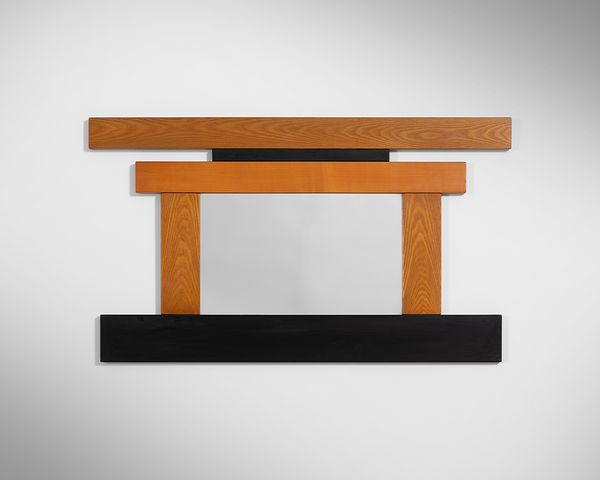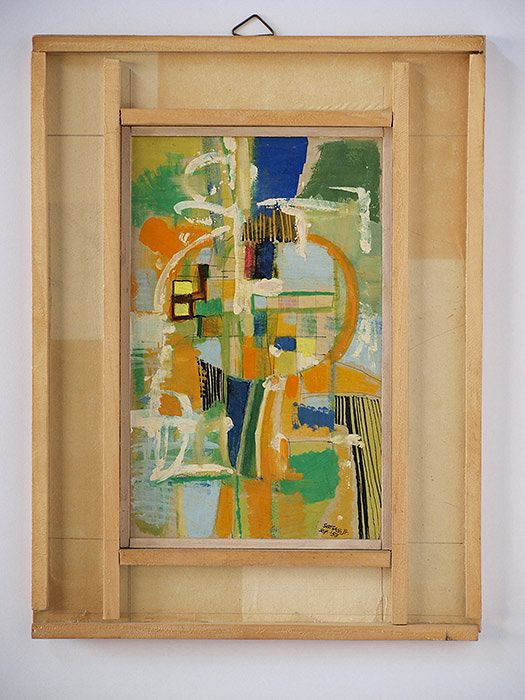Ettore Sotsass, Jr., Rare mirror, circa 1960. Design London.
By Fulvio Ferrari, author of 'Ettore Sottsass: Tutta la Ceramica' and 'Sottsass: 1000 Ceramics'
Seven large technical drawings, each on a 1:1 scale, and numerous models for a series of mirrors are still preserved in the Galleria Il Sestante Archive. These works were intended for an exhibition that opened in May 1960 on Via della Spiga in Milan, where Galleria Il Sestante was located.
Poster for the Collection of wooden frames and objects exhibition at Galleria del Sestante, Milan, 1960. Image: Il Sestante Archive-Museo Casa Mollino, Turin.
Who was Ettore Sottsass in the late 1950s? At this time, he was a forty-something, unconventional, and penniless individual. Marisa Scarzella, alongside her sister Lina, founded a novel, creative channel, a "gallery", to draw a conduit between ordinary life and the mysterious world of art. Instead of established artists to form the backbone of Il Sestante, the Scarzella sisters turned to obscure, yet promising talents to provide a new generation of artists with invaluable opportunities: Giò and Arnaldo Pomodoro, Nanni Valentini, Franco Bucci, Del Campo, Renato Bassoli, and Ettore Sottsass collectively constituted the founding members of this incubator of visionary creativity.
Sottsass was the only architect within this collective of artists, yet in essence he was an artist at heart. Rather than limiting himself to the confines of the traditional practices promoted by the architecture faculty in Turin, where he obtained his degree in 1939, he found nourishment for his creativity in the studios of painters. It was within these unconventional spaces that his artistic spirit flourished.
A blueprint drawing of the present Rare mirror. Image: Il Sestante Archive-Museo Casa Mollino, Turin.
Sottsass was a precise and meticulous man, the son of an architect, who inherited a rigorous work ethic from his father, characterized by personally sketching the frameworks for his creations. In 1953, he wrote that "architecture uses the same principles as painting." Indeed, he believed the frame had the potential to create a calm space around a work of art. The genesis of the designs for the Collection of wooden frames and objects exhibition can be found in a surviving tempera painting from the same year.
A tempera painting by Ettore Sottsass, 1963. Image: Il Sestante Archive-Museo Casa Mollino, Turin.
Sottsass's legacy transcends mere industrial and mass-produced design. His creations were first conceptualized as singular works of art. Later projects, such as the Elea computer for Olivetti, are now universally admired as artistic masterpieces. He once wrote: "Design doesn't mean giving shape to a product... For me, design is a way, it's a tool for discussing life."
This philosophy was extended in the late 1950s, when the artist Agenore Fabbri introduced Sottsass to the furniture manufacturing company Poltronova; he perceived furniture not as a collection of static objects but as a designed experience of a space’s essence.
Gloria Bianchino, who meticulously catalogued thousands of Sottsass's drawings, writes: “Ettore's myth is inseparable from the realm of art. His sophisticated and cultured sketches reflect a deep engagement with abstraction and later with informalism, positioning him as a central figure in Italian design and beyond.”
In a reflection on his artistic journey, published in an interview with Hans Ulrich Obrist in 2007, Sottsass recalled his beloved painting teacher Luigi Spazzapan, who imparted the belief that an artist must follow the path of magic — an anarchic approach to creation that goes against conventional constraints and penetrates the essence of the moment.
When we look at Sottsass's creations, we don't merely see mirrors; we encounter magic.
Discover More from Design London >
Recommended Reading
Beauty Suspended in Time: Shiro Kuramata >
A Masterpiece of Brazilian Modern Design >
Antiquity Made Modern: Diego Giacometti >
Elevation of the Human Spirit through Postmodern Design: Alessandro Mendini >



